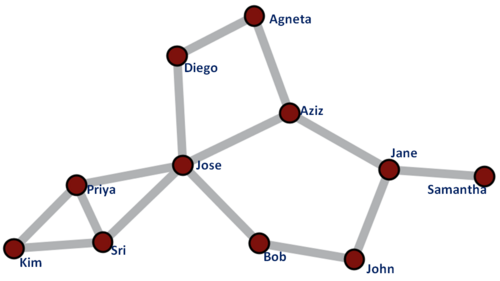Katz centrality
In graph theory, the Katz centrality of a node is a measure of centrality in a network. It was introduced by Leo Katz in 1953 and is used to measure the relative degree of influence of an actor (or node) within a social network.[1] Unlike typical centrality measures which consider only the shortest path (the geodesic) between a pair of actors, Katz centrality measures influence by taking into account the total number of walks between a pair of actors.[2]
It is similar to Google's PageRank and to the eigenvector centrality.
Measuring Katz centrality

Katz centrality computes the relative influence of a node within a network by measuring the number of the immediate neighbors (first degree nodes) and also all other nodes in the network that connect to the node under consideration through these immediate neighbors. Connections made with distant neighbors are, however, penalized by an attenuation factor .[3] Each path or connection between a pair of nodes is assigned a weight determined by and the distance between nodes as .
For example, in the figure on the right, assume that John’s centrality is being measured and that . The weight assigned to each link that connects John with his immediate neighbors Jane and Bob will be . Since Jose connects to John indirectly through Bob, the weight assigned to this connection (composed of two links) will be . Similarly, the weight assigned to the connection between Agneta and John through Aziz and Jane will be and the weight assigned to the connection between Agneta and John through Diego, Jose and Bob will be .
Mathematical formulation
Let A be the adjacency matrix of a network under consideration. Elements of A are variables that take a value 1 if a node i is connected to node j and 0 otherwise. The powers of A indicate the presence (or absence) of links between two nodes through intermediaries. For instance, in matrix , if element , it indicates that node 2 and node 12 are connected through some first and second degree neighbors of node 2. If denotes Katz centrality of a node i, then mathematically:
Note that the above definition uses the fact that the element at location of the adjacency matrix raised to the power (i.e. ) reflects the total number of degree connections between nodes and . The value of the attenuation factor α has to be chosen such that it is smaller than the reciprocal of the absolute value of the largest eigenvalue of the adjacency matrix A.[4] In this case the following expression can be used to calculate Katz centrality:
Here is the identity matrix, is an identity vector of size n (n is the number of nodes) consisting of ones. denotes the transposed matrix of A and denotes matrix inversion of the term .[4]
Applications
Katz centrality can be used to compute centrality in directed networks such as citation networks and the World Wide Web.[5] Katz centrality is more suitable in the analysis of directed acyclic graphs where traditionally used measures like eigenvector centrality are rendered useless.[5] Katz centrality can also be used in estimating the relative status or influence of actors in a social network.
References
- ^ Katz, L. (1953). A New Status Index Derived from Sociometric Index. Psychometrika, 39–43.
- ^ Hanneman, R. A., & Riddle, M. (2005). Introduction to Social Network Methods. Retrieved from http://faculty.ucr.edu/~hanneman/nettext/
- ^ Aggarwal, C. C. (2011). Social Network Data Analysis. New York, NY: Springer.
- ^ a b Junker, B. H., & Schreiber, F. (2008). Analysis of Biological Networks. Hoboken, NJ: John Wiley & Sons.
- ^ a b Newman, M. E. (2010). Networks: An Introduction. New York, NY: Oxford University Press.
























